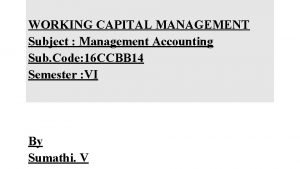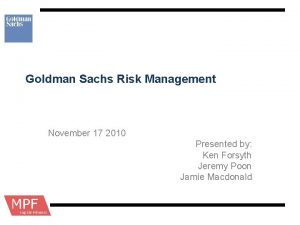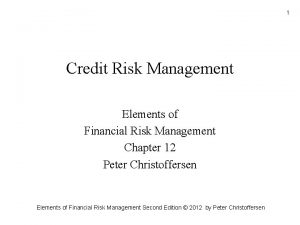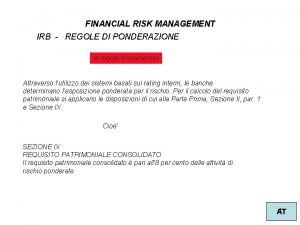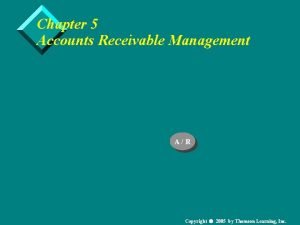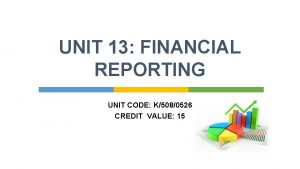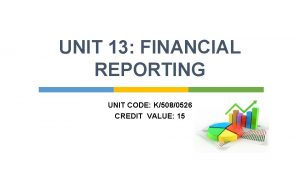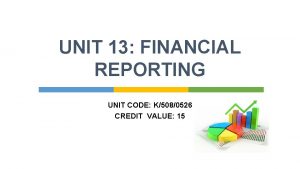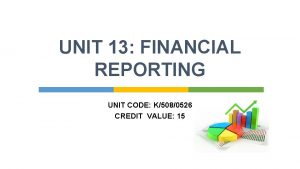UNIT 15 FINANCIAL MANAGEMENT Unit code M5080527 Credit




















![REFERENCES �Courses. lumenlearning. com. (2018). Overview of Ratio Analysis | Boundless Finance. [online] Available REFERENCES �Courses. lumenlearning. com. (2018). Overview of Ratio Analysis | Boundless Finance. [online] Available](https://slidetodoc.com/presentation_image/28b0ef66782230f374426ab8f79b7b10/image-21.jpg)
![REFERENCES �Educ. jmu. edu. (2018). [online] Available at: http: //educ. jmu. edu/~drakepp/principles/module 2/fin_rat. pdf REFERENCES �Educ. jmu. edu. (2018). [online] Available at: http: //educ. jmu. edu/~drakepp/principles/module 2/fin_rat. pdf](https://slidetodoc.com/presentation_image/28b0ef66782230f374426ab8f79b7b10/image-22.jpg)
- Slides: 22

UNIT 15: FINANCIAL MANAGEMENT Unit code M/508/0527 Credit value 15

UNIT 15: FINANCIAL MANAGEMENT �Learning Outcome 3: Evaluate the role of management accountants and accounting control systems.

THE BASIC SYLLABUS � 1 Apply different approaches used to support effective decision-making. � 2 Analyse financial management principles which are used to support effective financial strategies. � 3 Evaluate the role of management accountants and accounting control systems. � 4 Evaluate ways in which financial decision-making supports sustainable performance.

LEARNING OUTCOMES LO 4: Evaluate ways in which financial decision-making supports sustainable performance. P 5: Evaluate the ways in which financial decision making is important for supporting long term financial sustainability

OVERVIEW � Financial statements are generally insufficient to provide information to investors on their own; the numbers contained in those documents need to be put into context so that investors can better understand different aspects of the company’s operations. Ratio analysis is one of three methods an investor can use to gain that understanding. A financial ratio, or accounting ratio, is derived from a company’s financial statements and is a calculation showing the relative magnitude of selected numerical values taken from those financial statements.

FINANCIAL RATIOS �Cost control and reduction refers to the efforts business managers make to monitor, evaluate, and trim expenditures. These efforts might be part of a formal, company-wide program or might be informal in nature and limited to a single individual or department. In either case, however, cost control is a particularly important area of focus for small businesses, which often have limited amounts of time and money.

FINANCIAL RATIOS �There are various types of financial ratios, grouped by their relevance to different aspects of a company’s business as well as to their interest to different audiences. Financial ratios may be used internally by managers within a firm, by current and potential shareholders and creditors of a firm, and other audiences interested in understanding the strengths and weaknesses of a company, especially compared to the company over time or compared to other companies.

FINANCIAL RATIOS �Financial ratios as consisting of five basic types: �Profitability ratios measure the firm’s use of its assets and control of its expenses to generate an acceptable rate of return. �Liquidity ratios measure the availability of cash to pay debt. �Activity ratios, also called efficiency ratios, measure the effectiveness of a firm’s use of resources, or assets. �Debt, or leverage, ratios measure the firm’s ability to repay long -term debt. �Market ratios are concerned with shareholder audiences. They measure the cost of issuing stock and the relationship between return and the value of an investment in company’s shares.

FINANCIAL RATIOS �Financial ratios compare different line items in the financial statements to yield insights into the condition and results of a business. These ratios are most commonly employed by individuals outside of a business, since employees typically have more detailed information available to them. Nonetheless, senior managers must be conversant with the results of their key financial ratios, so that they can discuss the ratios with members of the investment community, creditors, and lenders.

FINANCIAL RATIOS

FINANCIAL RATIOS

FINANCIAL RATIOS

FINANCIAL RATIOS

FINANCIAL RATIOS

FINANCIAL RATIOS

FINANCIAL RATIOS � Leverage ratios are used to determine the relative level of debt load that a business has incurred. These ratios compare the total debt obligation to either the assets or equity of a business. A high ratio indicates that a business may have incurred a higher level of debt than it can be reasonably expected to service with ongoing cash flows. � The two main leverage ratios are: � Debt ratio. Compares assets to debt, and is calculated as total debt divided by total assets. A high ratio indicates that the bulk of asset purchases are being funded with debt. � Debt to equity ratio. Compares equity to debt, and is calculated as total debt divided by total equity. A high ratio indicates that the business owners may not be providing sufficient equity to fund a business.

FINANCIAL RATIOS �Market value ratios are used to evaluate the current share price of a publicly-held company's stock. These ratios are employed by current and potential investors to determine whether a company's shares are over-priced or under-priced. The most common market value ratios are as follows: �Book value per share. Calculated as the aggregate amount of stockholders' equity, divided by the number of shares outstanding. This measure is used as a benchmark to see if the market value per share is higher or lower, which can be used as the basis for decisions to buy or sell shares. �Dividend yield. Calculated as the total dividends paid per year, divided by the market price of the stock. This is the return on investment to investors if they were to buy the shares at the current market price.

FINANCIAL RATIOS �Earnings per share. Calculated as the reported earnings of the business, divided by the total number of shares outstanding (there are several variations on this calculation). This measurement does not reflect the market price of a company's shares in any way, but can be used by investors to derive the price they think the shares are worth. �Market value per share. Calculated as the total market value of the business, divided by the total number of shares outstanding. This reveals the value that the market currently assigns to each share of a company's stock. �Price/earnings ratio. Calculated as the current market price of a share, divided by the reported earnings per share. The resulting multiple is used to evaluate whether the shares are over-priced or under-priced in comparison to the same ratio results for competing companies.

FINANCIAL RATIOS �These ratios are not closely watched by the managers of a business, since these individuals are more concerned with operational issues. The main exception is the investor relations officer, who must be able to see the company's performance from the perspective of investors, and so is much more likely to track these measurements closely. �Market value ratios are not applied to the shares of privately-held entities, since there is no accurate way to assign a market value to their shares.

FINANCIAL RATIOS
![REFERENCES Courses lumenlearning com 2018 Overview of Ratio Analysis Boundless Finance online Available REFERENCES �Courses. lumenlearning. com. (2018). Overview of Ratio Analysis | Boundless Finance. [online] Available](https://slidetodoc.com/presentation_image/28b0ef66782230f374426ab8f79b7b10/image-21.jpg)
REFERENCES �Courses. lumenlearning. com. (2018). Overview of Ratio Analysis | Boundless Finance. [online] Available at: https: //courses. lumenlearning. com/boundless-finance/chapter/overview -of-ratio-analysis/ [Accessed 3 Apr. 2018]. �Bragg, S. and Bragg, S. (2018). Financial ratios. [online] Accounting. Tools. Available at: https: //www. accountingtools. com/articles/financialratios. html [Accessed 3 Apr. 2018]. �Netmba. com. (2018). Financial Ratios. [online] Available at: http: //www. netmba. com/finance/financial/ratios/ [Accessed 3 Apr. 2018].
![REFERENCES Educ jmu edu 2018 online Available at http educ jmu edudrakeppprinciplesmodule 2finrat pdf REFERENCES �Educ. jmu. edu. (2018). [online] Available at: http: //educ. jmu. edu/~drakepp/principles/module 2/fin_rat. pdf](https://slidetodoc.com/presentation_image/28b0ef66782230f374426ab8f79b7b10/image-22.jpg)
REFERENCES �Educ. jmu. edu. (2018). [online] Available at: http: //educ. jmu. edu/~drakepp/principles/module 2/fin_rat. pdf [Accessed 3 Apr. 2018]. � Bragg, S. and Bragg, S. (2018). Market value ratios. [online] Accounting. Tools. Available at: https: //www. accountingtools. com/articles/market-value-ratios. html [Accessed 3 Apr. 2018].
 Busceral
Busceral This can be avoided by giving credit where credit is due.
This can be avoided by giving credit where credit is due. Financial management subject code
Financial management subject code 3-5 credit cards financial algebra
3-5 credit cards financial algebra Best financial credit union
Best financial credit union Financial and non financial methods of motivation
Financial and non financial methods of motivation Oracle credit management application
Oracle credit management application Erm implementation roadmap
Erm implementation roadmap Credit risk management and advisory goldman sachs
Credit risk management and advisory goldman sachs Cost of granting credit
Cost of granting credit Credit management in o2c
Credit management in o2c Credit risk
Credit risk Elements of credit risk management
Elements of credit risk management Airplus corporate card
Airplus corporate card Cost in receivable management
Cost in receivable management Oracle credit checklists
Oracle credit checklists Metodo irb
Metodo irb Credit risk evaluation framework
Credit risk evaluation framework Credit standards in receivable management
Credit standards in receivable management Credit unit
Credit unit Types of credit - unit test
Types of credit - unit test Code élaboré code restreint
Code élaboré code restreint Managed and unmanaged code
Managed and unmanaged code


